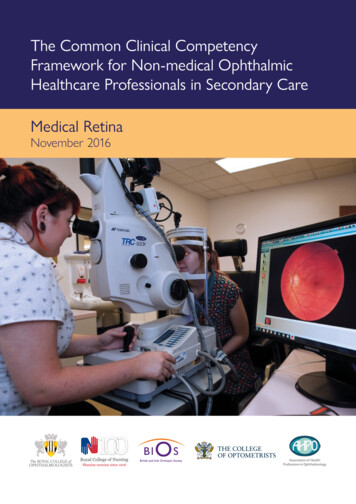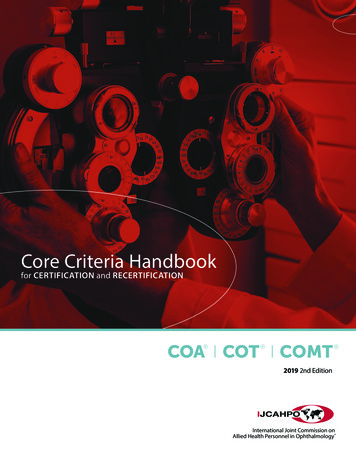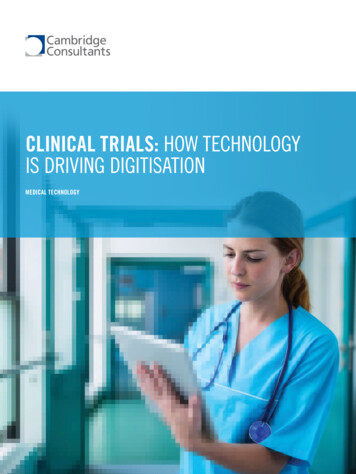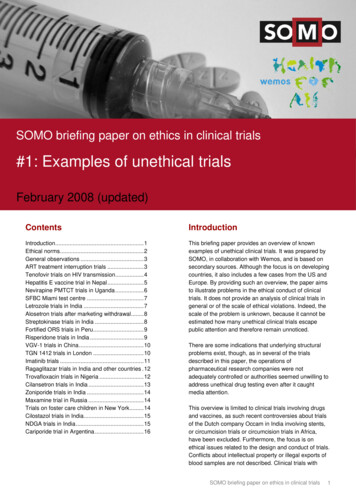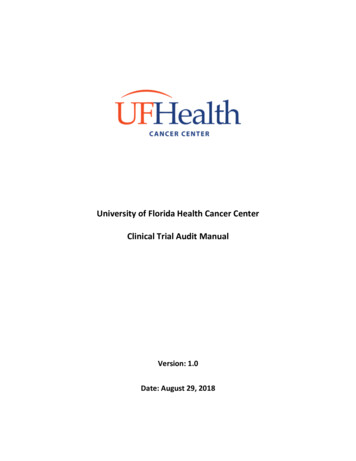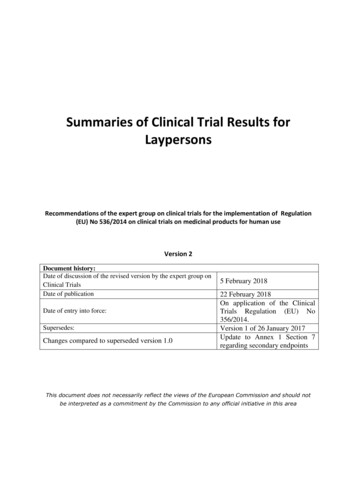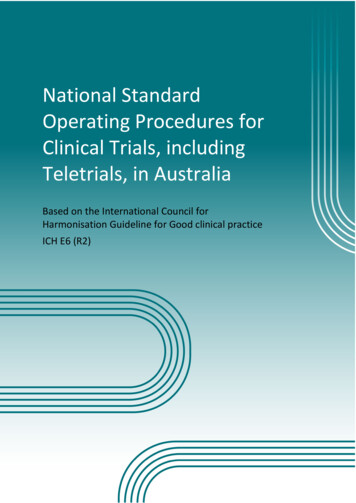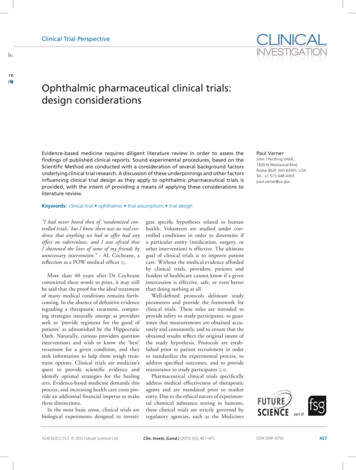
Transcription
Clinical Trial Perspectivetrials:Futurectivence15Ophthalmic pharmaceutical clinical trials:design considerationsEvidence-based medicine requires diligent literature review in order to assess thefindings of published clinical reports. Sound experimental procedures, based on theScientific Method are conducted with a consideration of several background factorsunderlying clinical trial research. A discussion of these underpinnings and other factorsinfluencing clinical trial design as they apply to ophthalmic pharmaceutical trials isprovided, with the intent of providing a means of applying these considerations toliterature review.Paul VarnerJohn J Pershing VAMC,1500 N Westwood Blvd,Poplar Bluff, MO 63901, USATel.: 1 573 448 4303paul.varner@va.govKeywords: clinical trial ophthalmic trial assumptions trial design“I had never heard then of ‘randomized controlled trials,’ but I knew there was no real evidence that anything we had to offer had anyeffect on tuberculosis, and I was afraid thatI shortened the lives of some of my friends byunnecessary intervention.” - AL Cochrane, areflection as a POW medical officer [1] .More than 40 years after Dr Cochranecommitted these words to print, it may stillbe said that the proof for the ideal treatmentof many medical conditions remains forthcoming. In the absence of definitive evidenceregarding a therapeutic treatment, competing strategies naturally emerge as providersseek to ‘provide regimens for the good ofpatients’ as admonished by the HippocraticOath. Naturally, curious providers questioninterventions and wish to know the ‘best’treatment for a given condition, and theyseek information to help them weigh treatment options. Clinical trials are medicine’squest to provide scientific evidence andidentify optimal strategies for the healingarts. Evidence-based medicine demands thisprocess, and increasing health care costs provide an additional financial impetus to makethese distinctions.In the most basic sense, clinical trials arebiological experiments designed to investi-10.4155/CLI.15.5 2015 Future Science Ltdgate specific hypotheses related to humanhealth. Volunteers are studied under controlled conditions in order to determine ifa particular entity (medication, surgery, orother intervention) is effective. The ultimategoal of clinical trials is to improve patientcare. Without the medical evidence affordedby clinical trials, providers, patients andfunders of healthcare cannot know if a givenintercession is effective, safe, or even betterthan doing nothing at all.Well-defined protocols delineate studyparameters and provide the framework forclinical trials. These rules are intended toprovide safety to study participants, to guarantee that measurements are obtained accurately and consistently, and to ensure that theobtained results reflect the original intent ofthe study hypothesis. Protocols are established prior to patient recruitment in orderto standardize the experimental process, toaddress specified outcomes, and to providereassurance to study participants [2,3] .Pharmaceutical clinical trials specificallyaddress medical effectiveness of therapeuticagents and are mandated prior to marketentry. Due to the ethical nature of experimental chemical substance testing in humans,these clinical trials are strictly governed byregulatory agencies, such as the MedicinesClin. Invest. (Lond.) (2015) 5(5), 457–475part ofISSN 2041-6792457
Clinical Trial PerspectiveVarnerand Healthcare Products Regulatory Agency in theUnited Kingdom, European Medicines Agency inthe European Union, Pharmaceutical and MedicalDevices Agency in Japan, The National Agency forSanitary Vigilance in Brazil, and the US FDA.Ophthalmic pharmaceutical clinical trials are thoseresearch studies designed to investigate the effectiveness of medications in reducing ocular morbidity, andthey follow the same guidelines as other trials involving pharmaceutics. Considering that approximately60% of all medical research funding is supplied byindustry [4,5] , a majority of ophthalmic pharmaceuticalclinical trials falls under the aegis of Pharma. Thus anunderstanding of these trial designs is imperative forclinicians to interpret publications in the ophthalmicliterature.Trial underpinningsWhat constitutes an ideal clinical trial?Consideration of any clinical trial design must beginwith an important caveat: no clinical trial design,observation method or data set is perfect [6] . Following the Scientific Method, clinical trials seek to answerbiological questions by regimented, experimentalmeans; however, it is the design of those experimentsthat determine scientific success or failure [7] . Understanding the different facets of clinical trial designhelps readers of medical literature better interpretstudy findings.In general, the goal of clinical research study designis to reduce bias, defined as any tendency that prevents unprejudiced consideration of a question [8] . Inmedical research, bias can result in distortion of a statistical finding away from the true value and can bethe result of the data sampling process [9] . The introduction of bias can occur at any stage of the researchprocess (planning, implementation or analysis), andis nearly always present to some degree in publishedstudies [10] .The expectations for a clinical trial are exceedinglydemanding. The design of any research trial shouldreduce bias, allow for the collection of precise data,prevent statistical over-analysis, be highly reproducibleand yield results that are clinically significant. In addition to controlling for potential bias, clinical trials thatmeet these basic requirements also satisfy the ethicalconsiderations for human trials, allow for efficient useof trial resources, reduce the possibility of confounding, control for precise measurements, reduce randomeffects, simplify data analysis and increase the externalvalidity of the trial [11] . It is also important to emphasize that skilful statistical calculations cannot overcomethe shortcomings of poor trial design. These observations hold true for all clinical trials – including those458Clin. Invest. (Lond.) (2015) 5(5)involving ophthalmic pharmaceuticals – and are theculmination of Dr Cochrane’s challenge to medicinethose decades ago.Expectations of researchersDo investigator expectations determine outcomes?Expectancy Theories of behavior indicates thathumans make decisions based on desired outcomes [12] .This phenomenon has not yet been directly studiedwith respect to trial design in medical research, butsophisticated clinical trial designs seek to mitigatethese effects.It may be surmised that medical researchers areswayed by questions of funding, complex trial regulations, excessive monitoring, issues of patient privacyand misunderstandings regarding methodology [13]– interesting considerations beyond the scope of thispaper. The effect of corporate sponsorship on researchis well-known, but parallel consequences for independent or government-sponsored research remainindeterminate.Investigator behavior can affect many factors inclinical research: selection of sample sizes, masking,choice of study vehicles, etc. Readers should be awareof the possibility that options of study design parameters can be made without conscious realization thatsuch decisions may inadvertently influence the entirestudy, and, therefore, the reported outcomes. In thepresent research environment involving multiple investigators and sites, it is hoped that these considerationsare minimized or at least counter-balanced in theplanning stages of clinical research.Underlying trial assumptionsAlthough not explicitly stated, all clinical pharmaceutical trials are predicated on two underlying assumptions.First, the natural history of the disease must be understood well enough to believe that an intervention willreduce morbidity or – rarer for ophthalmic cases – mortality. Second, preliminary studies conducted using animal models (or more infrequently, human donor tissuefor selected surgical interventions) must have suggesteda benefit for human testing. In practice, animal modelsare necessary to gain understanding of human diseasemechanisms and to investigate new treatments [14] .The challenge for researchers continues to be locatingappropriate animal models and extrapolating harvesteddata to humans [15] . Because not all data derived fromanimal studies may be applied to human physiology,subsequent testing on humans is still required. This isspecifically true for human studies of eyes, which arehighly specialized neurological tissues in primates.Discerning the natural history of some diseasesremains a challenge, as most providers can cite mul-future science group
Ophthalmic pharmaceutical clinical trials: design considerationstiple examples of ‘exceptions to the rule’ of clinicalcourses. It may be surmised that these exceptions aredisease variants – or perhaps unrecognized subtypes –that may not follow the same course as ‘typical’ cases.Great care must be exercised during the patient selection process in an attempt to identify variant presentations in order that clinical research trials target only asingle disease entity.Ophthalmic examples to demonstrate this concept abound. The natural history of cataract can stillbe seen everywhere in the world due to various challenges of access to healthcare that serve as barriers tothe amelioration of this common eye disease. Althoughthere is currently no treatment for cataract (i.e., reducing lenticular opacification – cataract surgery is prosthetic rehabilitation), the natural history is still seenfrequently enough for all clinicians to agree generallyupon a similar pattern of development. For this medical condition, there has been no formal research trialto ‘prove’ efficacy of modern cataract surgery. Indeed,most clinicians would consider such to be superfluous and probably unethical. Cataract extraction andsecondary prosthetic lens implantation is accepted asa viable, very successful, low-risk alternative to thenatural history of the disease.Treatment for the natural course of other ophthalmic diseases may not be so clear cut. As an alternativeexample to cataract and its highly successful remediation, consider proliferative diabetic retinopathy(PDR). Due to the lack of standardized treatmentavailable for PDR prior to the Diabetic RetinopathyStudy (DRS), the natural history of the neovascularphase of the disease and its profound complicationswere – unfortunately – well-known to clinicians. Thiswide-spread recognition provided the impetus forstudy of alternatives to the untreated natural course ofthis disease.Beginning with Meyer-Schwickerath’s pioneeringwork with ophthalmic xenon photocoagulators in the1950s, researchers quickly realized that retinal photoablation could alter the course of PDR [16] . But whichwavelength photocoagulator, what criteria should betreated, and how much retinal tissue should be treatedto provide the most effective treatment for PDR? Rigorous clinical trials answered these important clinicalquestions. The DRS demonstrated the superiority ofargon scatter panretinal laser photocoagulation in altering the natural course of this disease [17] and offeredspecific treatment guidelines for clinicians to follow.In fact, laser photocoagulation based on the results ofthe DRS remains the primary treatment for PDR morethan 30 years after publication of these findings.Interestingly enough, the mechanism for the effectiveness of laser photocoagulation remains unknownfuture science groupClinical Trial Perspectiveand clinical trials have yet to demonstrate effectivenessof therapeutic agents for ophthalmic complications ofdiabetes [18] . However, perhaps this should come as nosurprise as an exact animal model for PDR remainselusive [19] . Indeed, future ophthalmic pharmaceutical clinical trials must demonstrate their effectivenessagainst laser photocoagulation – the gold standard fortreatment of PDR.Contrary to cataract and PDR, the natural historiesof other common, chronic ophthalmic diseases are lessclear. A limited amount of clinical data is available forthe natural histories of open-angle glaucoma [20] andsome forms of age-related macular degeneration [21,22] ;regrettably, there are currently no treatments availableto greatly alter the natural progression of these highlyprevalent ophthalmic conditions across a broad spectrum of affected patients. It must be reiterated, though,at present there are no animal models available to facilitate this ophthalmic research – somehow a connectionto humans based on tissue-ablative animal models islacking.Ethical considerationsMedical research trials are conducted under a combination of concepts: equipoise and the uncertainty principle. Equipoise implies that there must be a genuinedoubt in the mind of an individual investigator regarding which intervention in a trial is better [23] . Theuncertainty principle (alternatively, and confusinglytermed ‘clinical equipoise’) embodies the broader ideathat there is general doubt within the medical community regarding two treatment options [24] . While bothnotions have been questioned [25–27] , the general ideasare important bases for clinical trials in medicine –especially pharmaceutical research.Consider treatment options for ocular melanoma,an eye disorder with life-threatening implications:debate regarding the importance of/need for the Collaborative Ocular Melanoma Study (COMS) occurredprior to its initiation [28–30] . In the absence of definitivedata regarding enucleation – the most profound ophthalmic intervention possible – a significant number ofinvestigators at multiple sites were directly confrontedwith these important ethical concepts. Ultimately,enough uncertainty among ocular oncologists existedin order to facilitate completion of the COMS and theimportant results of its three branches [31] .Although not explored for ophthalmic pharmaceutical clinical trials, oncology and rheumatology researchindicate that industry-funded trials violate these ethical principles [32,33] , and this seems applicable to othermedical specialties. Equipoise and clinical uncertainty underlie the ‘Principle of Clinical Discovery,’under which veritable scientific study via randomizedwww.future-science.com459
Clinical Trial PerspectiveVarnercontrolled (or clinical) trials (RCTs) predicts no morethan a 50% success rate (i.e., 50/50 outcomes) fordiscovering new treatments [34] .Ultimately then, equipoise and the uncertainty principle are the unstated, yet underlying principle in thedetermination of a clinical gold standard, so necessaryto evidence-based medicine.Gold standardThis term – borrowed from economists who referencedthe precious metal – has been co-opted by medicineto indicate the current standard for a diagnostic test,medical procedure, or clinical method [35] . Whethera true gold standard for healthcare is ever attainedis a matter of debate [36,37] ; however, the use of thisterm is so widespread in the medical community thatthe phrase does provide a standard of reference fordiscussion of clinical research.There are many claims of a gold standard, but it mustbe remembered that this can only truly be determinedby scientific study. Expert opinion notwithstanding,until proved otherwise, the default gold standard forany disease is nil. Medical intervention – hopefullybased on sound understanding of the natural courseof the disease, and with appropriate animal modelsdemonstrating preliminary effectiveness for a treatment – is pursued with the intent of reducing morbidity. For ophthalmic research this most often translatesto restoring – or at least maintaining – visual function.Only once an intervention improves upon the naturalcourse of the disease can it be said to become the newgold standard.In order to satisfy the ethics of equipoise and theuncertainty principle, and in order to reduce investigator bias, the best RCT designs to determine goldstandards include placebo or sham control (discussedbelow) whenever possible. Surgery and instances ofoverwhelming evidence of obvious treatment effect arenotable exceptions. Once a therapeutic standard of careis established over the natural course of the disease (orthe placebo for masked RCTs), further studies shouldprovide head-to-head comparisons of new interventions against the current clinical standard. A placeboshould not, in good conscience, be used in the presenceof a well-established standard of care. Failure to followthis ethical practice should alert all clinicians to thepossibility of a marketing study versus a scientific one.Following the Principle of Clinical Discovery, goldstandards change with time. Intracapsular cataractextraction with aphakic spectacle correction was animprovement over the natural history of cataract formation, but was replaced with a new gold standard inextracapsular cataract extraction. Phacoemulsificationfurther advanced the technique of cataract surgery, and460Clin. Invest. (Lond.) (2015) 5(5)represents the current gold standard for surgical lenticular pathology. As future interventions are developedand tested, those procedures must be compared withphacoemulsification in order to determine a possible,new optimal treatment for this condition.A few important changes in ophthalmic retinalgold standards over the past decade include: intravitreal anti-VEGF injections for: neovascular age-relatedmacular degeneration (AMD) over sham treatment(de facto observation) [38] ; persistent clinically-significant macular edema versus focal coagulation [39] ; andretinal venous occlusion over sham treatment (alsode facto observation) [40] .During the same time frame, gold standard equivalent results have been reported for digital imagingversus clinical examination for diabetic retinopathy [41] , bevacizumab and ranibizumab for neovascular AMD [42,43] , tube shunt surgery and trabeculectomy for poorly controlled glaucoma [44] , andDescemet’s stripping automated endothelial keratoplasty versus penetrating keratoplasty for chroniccorneal edema [45] .Note: In some cases, RCTs are not performedagainst the gold standard. The treatment of effect ofpenicillin against bacterial infection was so great thatplacebo-controlled comparison was unnecessary [24] .Similarly for ophthalmic trials, photodynamic therapyfor neovascular AMD [46] was not compared withmacular photocoagulation (the first gold standard forsubfoveal choroidal neovascularization) due to thelimitations of the latter mode of therapy to improvefunctional visual outcomes. Similarly, use of neodymium-YAG laser was not directly compared with surgical dissection for posterior capsular opacification dueto the immediate recognition of the superiority of thenoninvasive alternative [47] .In addition to the treatments, changes in the clinical trial designs themselves undergo permutations todiscover best practices. The Principle of Clinical Discovery also applies here, and the RCT has become thecurrent gold standard in clinical research and ophthalmic studies [48,49] . Thus, results of nonrandomized oruncontrolled clinical research are not received with thesame credence as data derived from RCTs.Study sponsorshipFunding for clinical trials is generally provided by government, commercial (biotechnology, medical device,pharmaceutical) or nonprofit entities. To date thedirect effect of the sponsor on the reporting of ophthalmic clinical trial information has not been reported;however, concern has been expressed regarding maintenance of scientific integrity under the sponsorship ofPharma in general [50] .future science group
Ophthalmic pharmaceutical clinical trials: design considerationsAs a measure of transparency for medical reporting, authors are asked to disclose potential conflicts ofinterest with their scientific publications, and clinicaltrial registry [51] is required prior to publication in mostmedical journals [52] . Readers are provided these extrameasures of credibility for clinical research papers.Unfortunately, even after the courageous move bymedical journal editors to mandate clinical trial registration prior to publication, underreporting continues.Results from less than half of all registered trials remainunavailable for critical assessment [53,54] , with a trendthat industry-sponsored trial results are less likely to bepublished [54] . Diligent reviewers of medical literatureare left to marvel at this finding. Does this mean that amajority of clinical research reflects negative findings,and therefore are undisclosed? This gap in reporting isboth intriguing and troubling.The direct effects of sponsorship on the specifics ofstudy design have not been described, but in light ofthis nonreporting – and because negative reports tendto be underreported [55] – the results of proprietarystudies that do appear in journals should be interpretedwith the understanding that the results of many studiesremain hidden from the public domain.Finally, industry is not the only source of conflict ofinterest in ophthalmic research. Pressures within academia [56] and political factors surely both influencepriorities of ophthalmic research, but have not beensystematically studied.Quality of clinical reportingThe purpose of medical reporting is to create a public and professional forum for human health research,and has generally become more sophisticated over time.More than 20 years ago, the CONsolidated StandardsOf Reporting Trials (CONSORT) group of expertsrealized the poor quality of reported RCTs and sought torectify this deficit. The CONSORT group has producedan evolving checklist to assist researchers in the standardized publication of RCTs [57] , and this represents aminimum standard of reporting for clinical research [58] .The top four ranking journals in general clinicalophthalmology either require [59–61] or encourage [62]adherence to the CONSORT statement for manuscriptsubmission in order to provide more meaningful publications of results to benefit readers. Despite such ambitious recommendations, these same four journals show‘substantial heterogeneity’ in quality of reporting [63] .Although informal review of several National Eye Institute-sponsored studies in the US showed general compliance to initial CONSORT guidelines [64] , regrettably there is little evidence to show overall improvedadherence of ophthalmic reports to the CONSORTguidelines between 2001 [65] and 2011 [66] .future science groupClinical Trial PerspectiveA reminder of these important underpinnings ofclinical research now allows for careful considerationof the specifics of the structure of clinical trials.Trial structureResearch trials vary by the type of study and designused to relay the discovered information. Terminology varies, but Figure 1 broadly classifies the two mainkinds of research studies – observational and experimental – and also summarizes the most importantstudy design considerations.Type of studyAlthough no ideal clinical trial structure has yet been discovered, some trial designs lend themselves better to certain findings than others. There is a natural progressionof clinical trial design that is corollary to clinical discovery and reporting. All medical literature is replete withcase reports of novel or variant clinical conditions. Singlereports form the basis of preliminary clinical understanding, and the ophthalmic literature is no exception. Publication of modern case reports is largely contingent uponnovel contribution to medical knowledge or to updatechanges in diagnostic or clinical practice [67] .Claims of therapeutic or preventive interventions generally require stronger evidence than can beobtained from a single case, so are typically conveyedas a case series (usually three or more cases). Bothcase reports and case series can be observational orexperimental, depending on the intent of the author(s).Case-control and Cohort forms of observationalstudies give much information regarding clinical features of diseases as well as prevalence and incidencedata. Frequently-occurring conditions are most oftenreported with a cohort (a group sharing a particularcharacteristic [68]), though these reports seldom call itsuch. For conditions that are rare, case-control studiesare used to compare an individual with the representative condition (the ‘case’) to a similar, normal patient(i.e., the ‘control’) for the purposes of extractingclinically useful information.Experimental clinical trials test hypotheses relatedto human disease, are more structured, and are mostoften controlled and randomized (i.e., RCT). A majority of clinical research and Phase III pharmaceuticaltrials fall into this category, although in certain casesa Controlled Clinical Trial may be performed beforea formal RCT (e.g., Phase I/II pharmaceutical trials).Design of studyStudy designs vary by the type of information thatresearchers hope to discover.Cross-sectional observational studies provide a snapshot of disease prevalence at one point in time, whereaswww.future-science.com461
Clinical Trial PerspectiveVarnerResearch studiesExperimental, interventional, analyticalObservational, descriptiveDesign of studyType of studyUncontrolledCohortCase-controlCase reportControlledRCTCCTCase seriesCross-sectional/prevalenceParallel vs crossoverLongitudinal/incidenceSuperiority, equivalence, non-inferiorityRetrospective vs prospectiveMasked vs open-labeledFigure 1. Summary of clinical research types and designs.CCT: Controlled clinical trial; RCT: Randomized controlled trial.longitudinal research gives information about incidentcases over time. These are mutually exclusive studydesigns. Population-based studies are specific longitudinal studies that yield long-term data regardingdisease incidences within a specific geographic area.Observational data can be obtained in retrospective or prospective fashion, depending on the intent ofthe researchers. Retrospective studies examine clinical data ex post facto, but seek to delineate informationregarding potential treatment options, which can onlybe confirmed via prospective clinical research.Controlled trials provide the best scientific methodfor biological experimentation and are all prospectivein nature. In these studies, there are well-defined protocols and mechanisms in place to prevent bias andto offer clinical treatment based on rigorous medicalstudy. Controlled studies seek to eliminate multiplevariables and confounders that can confuse data interpretation. Randomization (to be discussed) helps further decrease bias and is typically employed in clinicalpharmaceutical trials. These considerations help formthe basis of a RCT and are crucial in pharmaceuticalstudies where researchers seek to determine clinicalsuperiority without bias.Parallel RCTs compare treatments (A vs B). Thisis the most common of experimental studies, but is462Clin. Invest. (Lond.) (2015) 5(5)not often explicitly stated as being such. Crossoverstudies compare all treatments in all groups (A vsB; then B vs A). Crossover trials have the advantageof an additional means of control in comparing onetreatment against another in the same subject, butwith the disadvantages of additional study time andexpense.Superiority trials seek to demonstrate that onetreatment is more advantageous than another (A isbetter than B), and these designs are commonly used.Equivalence trials only strive to demonstrate equality of interventions (A B); whereas noninferioritytrials intend to show that one treatment is no worsethan a second (B is no worse than A). Noninferiority design is most appropriately used when the goldstandard is nil – the most robust application of theuncertainty principle. This choice in study designmay be related projected treatment effect, which inturn affects sample size determination (see below).Masked trials obscure treatment options fromparticipants; open-labeled trials remove masking.In general double masking of participant and investigator is preferable in order to reduce biased studyresults (more below).A well-written RCT report clearly distinguishesthese various trial characteristics.future science group
Ophthalmic pharmaceutical clinical trials: design considerationsTrial design considerationsDuring the 20th Century, medicine underwent a paradigm shift from the treatment of acute, infectiousconditions with obvious signs and symptoms overshort durations to management of chronic, multifactorial diseases with more subtle, life-long courses. Theastounding successes of the Penicillin Revolution arelong gone and the focus of medicine has now shiftedto chronic diseases [69] . Like other medical specialties,a review of any current ophthalmology journal revealsthe overabundance of articles dealing with chronicconditions versus those of an acute nature.The consequence of this shift from acute to chronicdiseases is that cure rates are rarely mentioned.Rather, more modest treatment effects of medicalinterventions are considered. In fact, the realizationof ‘large’ treatment effects for chronic diseases may beunrealistic [24] , and this certainly seems to be the casein current ophthalmic research.An examination of the components of clinical trialdesign reveals how intricate modern medical researchhas become. An understanding of these featureshelps readers interpret findings in terms of narrowtreatment effects.Trial lengthThe ideal length for an ophthalmic pharmaceuticalclinical trial has not been determined. However, anonsystematic review of some ophthalmic pharmaceutical trials is instructive (Table 1, Phase III trialsreported when possible). This informal review suggests a dichotomy between topical treatments andother ophthalmic interventions.Appropriate length for topical ophthalmic pharmaceutical clinical trials in acute settings (infectious orallergic) appears to be in the 2–4 week range, whereasfor chronic ophthalmic conditions, trial lengthefficacy tends to be reported for 3–6-month periods.Non-topical ophthalmic treatment trials tend
goal of clinical trials is to improve patient care. Without the medical evidence afforded by clinical trials, providers, patients and funders of healthcare cannot know if a given intercession is effective, safe, or even better than doing nothing at all. Well-defined protocols delineate study parameters and provide the framework for clinical trials.
